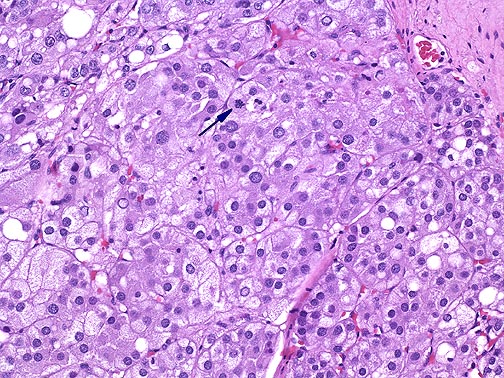英国的一项新研究显示,检测尿液中某些类固醇的含量能够帮助诊断肾上腺癌,这种新诊断方法的准确度较高,比常用的CT扫描诊断技术更为方便。

英国伯明翰大学等机构的研究人员在新一期美国《临床内分泌学与新陈代谢杂志》上报告说,肾上腺部位的肿瘤有良性和恶性之分,它们会导致尿液中一些类固醇的含量发生变化。通过运用一种名为“气相色谱—质谱法”的检测技术,可以检测出尿液中的相关类固醇含量,从而帮助判断是否存在恶性肿瘤。试验显示这种方法的准确度可达90%。
领导这项研究的维布克•阿尔特教授说,这是首个用于诊断肾上腺癌的尿检方法,比目前常用的CT扫描技术更为方便。此外,由于CT扫描的诊断准确度有时不理想,病人往往要接受多次扫描,反复暴露于辐射下,而尿检则可以避开辐射。
据介绍,由于肾上腺距离体表较远,这一部位的肿瘤往往难以发现,经常是在恶性肿瘤变大或扩散后,在做常规CT检查时才发现,而这时已处于癌症晚期,难以治愈。新的尿检方法有助于尽早发现肾上腺恶性肿瘤。
生物探索推荐英文论文摘要:
Urine Steroid Metabolomics as a Biomarker Tool for Detecting Malignancy in Adrenal Tumors
Context: Adrenal tumors have a prevalence of around 2% in the general population. Adrenocortical carcinoma (ACC) is rare but accounts for 2–11% of incidentally discovered adrenal masses. Differentiating ACC from adrenocortical adenoma (ACA) represents a diagnostic challenge in patients with adrenal incidentalomas, with tumor size, imaging, and even histology all providing unsatisfactory predictive values.
Objective: Here we developed a novel steroid metabolomic approach, mass spectrometry-based steroid profiling followed by machine learning analysis, and examined its diagnostic value for the detection of adrenal malignancy.
Design: Quantification of 32 distinct adrenal derived steroids was carried out by gas chromatography/mass spectrometry in 24-h urine samples from 102 ACA patients (age range 19–84 yr) and 45 ACC patients (20–80 yr). Underlying diagnosis was ascertained by histology and metastasis in ACC and by clinical follow-up [median duration 52 (range 26–201) months] without evidence of metastasis in ACA. Steroid excretion data were subjected to generalized matrix learning vector quantization (GMLVQ) to identify the most discriminative steroids.
Results: Steroid profiling revealed a pattern of predominantly immature, early-stage steroidogenesis in ACC. GMLVQ analysis identified a subset of nine steroids that performed best in differentiating ACA from ACC. Receiver-operating characteristics analysis of GMLVQ results demonstrated sensitivity = specificity = 90% (area under the curve = 0.97) employing all 32 steroids and sensitivity = specificity = 88% (area under the curve = 0.96) when using only the nine most differentiating markers.
Conclusions: Urine steroid metabolomics is a novel, highly sensitive, and specific biomarker tool for discriminating benign from malignant adrenal tumors, with obvious promise for the diagnostic work-up of patients with adrenal incidentalomas.







